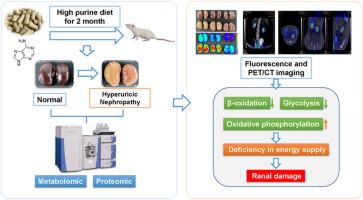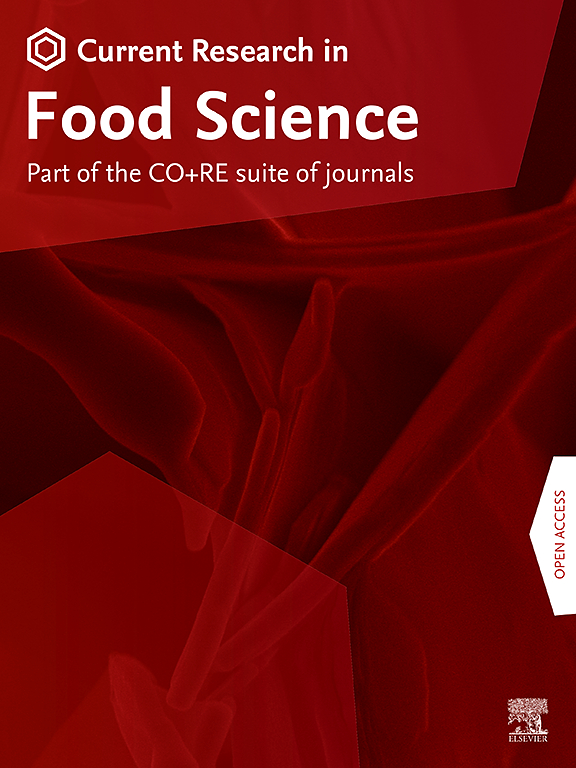高嘌呤饮食引起的能量不足:高尿酸血症肾病大鼠模型肾功能损伤的催化剂
IF 6.2
2区 农林科学
Q1 FOOD SCIENCE & TECHNOLOGY
引用次数: 0
摘要
高嘌呤饮食是高尿酸血症的一个重要风险因素,这种饮食可能会加剧高尿酸血症肾病。尽管如此,高嘌呤饮食引发肾脏损害的机理基础仍值得进一步研究。在本次研究中,通过高嘌呤饮食诱导建立了高尿酸血症肾病大鼠模型。随后,通过代谢组学和蛋白质组学分析,探讨了肾脏的代谢特征,并揭示了相应的机理途径。最后,利用荧光成像和18F-氟脱氧葡萄糖正电子发射计算机断层扫描(18F-FDG-PET/CT)来验证总体能量代谢状态。结果显示,通过高嘌呤饮食诱导八周后,高尿酸血症肾病大鼠的肾脏受到了广泛损伤。我们利用代谢组学发现,高嘌呤饮食组的酰基肉碱和左旋肉碱减少,表明脂肪酸代谢异常。通过蛋白质组学和共表达网络分析,我们发现高尿酸血症肾病大鼠肾脏中与脂肪酸β-氧化、糖酵解和氧化磷酸化相关的代谢物和酶存在异常。荧光成像和18F-FDG-PET/CT的应用证实了高尿酸血症肾病大鼠肾脏内脂肪酸β氧化和糖酵解受到抑制。相反,氧化磷酸化功能却得到了补偿性增强。鉴于肾功能的主要能量供应来自脂肪酸β-氧化代谢途径,该途径的任何中断都可能导致肾脏能量供应不足。这种能量不足可能为最终的肾功能损害奠定基础。此外,本研究还发现过氧化物酶体增殖激活受体信号通路受到抑制,这可能会进一步加剧β氧化功能的障碍。综上所述,能量供应不足在高尿酸血症肾病大鼠肾脏损伤中起着关键作用,因此在治疗高尿酸血症肾病时应更加关注肾脏能量供应。本文章由计算机程序翻译,如有差异,请以英文原文为准。

Energy insufficiency induced by high purine diet: Catalysts for renal impairment in hyperuricemia nephropathy rat model
A high purine diet emerges as a significant risk factor for hyperuricemia, and this diet may potentiate hyperuricemia nephropathy. Despite this, the mechanistic underpinnings of kidney damage precipitated by a high purine diet warrant further research. In the current investigation, a hyperuricemia nephropathy rat model was developed through induction via a high purine diet. Subsequently, metabolomic and proteomic analyses were employed to explore the metabolic characteristics of the kidney and shed light on the corresponding mechanistic pathway. Finally, fluorescence imaging and 18F-fluorodeoxyglucose positron emission tomography computed tomography (18F-FDG-PET/CT) were utilized to validate the overarching energy metabolism state. The results revealed extensive damage to the kidneys of hyperuricemia nephropathy rats following eight weeks of induction via a high purine diet. We used metabolomic to found that acyl carnitines and L-carnitine reduced in high purine diet group, indicated abnormal fatty acid metabolism. Irregularities were discerned in metabolites and enzymes associated with fatty acid β-oxidation, glycolysis, and oxidative phosphorylation within the kidneys of hyperuricemia nephropathy rats by proteomic and co-expression network analysis. The application of fluorescence imaging and 18F-FDG-PET/CT substantiated the inhibition of fatty acid β-oxidation and glycolysis within the kidneys of hyperuricemia nephropathy rats. On the contrary, a compensatory enhancement in the function of oxidative phosphorylation was observed. Given that the primary energy supply for renal function was derived from the metabolic pathway of fatty acids β-oxidation, any disruption within this pathway could contribute to a deficit in the energy provision to the kidneys. Such an energy insufficiency potentially laid the groundwork for eventual renal impairment. In addition, inhibition of the peroxisome proliferator-activated receptors signaling pathway was noted in the present findings, which could further exacerbate the impediment in the β-oxidation function. In conclusion, it was discerned that a deficiency in energy supply plays a critical role in the kidney injury in hyperuricemia nephropathy rats, thereby endorsing paying more attention to renal energy supply in the therapy of hyperuricemia nephropathy.
求助全文
通过发布文献求助,成功后即可免费获取论文全文。
去求助
来源期刊

Current Research in Food Science
Agricultural and Biological Sciences-Food Science
CiteScore
7.40
自引率
3.20%
发文量
232
审稿时长
84 days
期刊介绍:
Current Research in Food Science is an international peer-reviewed journal dedicated to advancing the breadth of knowledge in the field of food science. It serves as a platform for publishing original research articles and short communications that encompass a wide array of topics, including food chemistry, physics, microbiology, nutrition, nutraceuticals, process and package engineering, materials science, food sustainability, and food security. By covering these diverse areas, the journal aims to provide a comprehensive source of the latest scientific findings and technological advancements that are shaping the future of the food industry. The journal's scope is designed to address the multidisciplinary nature of food science, reflecting its commitment to promoting innovation and ensuring the safety and quality of the food supply.
 求助内容:
求助内容: 应助结果提醒方式:
应助结果提醒方式:


